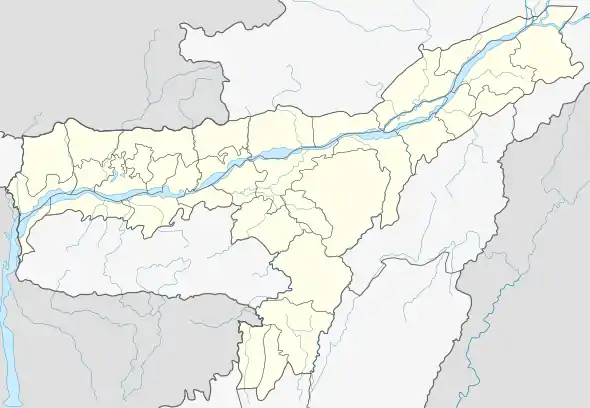Lanka (town)
Located in Hojai,Assam,Lanka is a town and a town area committee .It has 11 wards in it.It serves as trade and commerce hub for nearby areas such as Udali, Nokhuti, Laskar Pather, Karikhana, Kheroni, Dablong and doiyong sides. It is connected to NH27 which is connected to guwahati and other cities and states.
Lanka | |
|---|---|
Town | |
 Lanka Location in Assam, India  Lanka Lanka (India) | |
| Coordinates: 25°55′N 92°57′E | |
| Country | |
| State | Assam |
| District | Hojai |
| Government | |
| • Body | Lanka Municipality Board |
| Population (2011) | |
| • Total | 36,805 (town) 398,921[1] (circle) |
| Languages | |
| • Official Languages | Assamese, English |
| • Most spoken languages | Sylheti(Bengali) |
| Time zone | UTC+5:30 (IST) |
| PIN | 782446 |
| Telephone code | 03674 |
| ISO 3166 code | IN-AS |
| Vehicle registration | AS 31 |
Etymology
Lanka name is probably given after the name Lanka of Ramayana. Assamese poet Madhava Kandali was said to be inhabitant of Lanka,[2] who wrote Saptakanda Ramayana, under the patronage of Varāha-Rājā Mahamanikya.
Geography
Lanka town of Hojai District, Assam is located about 11 km from the district headquarter Sankar Dev Nagar.
Demographics
As of 2001 India census,[3] Lanka is a Municipal Board having 11 Wards. Lanka had a population of 36,805.[4] Males constitute 52% of the population and females 48%. Lanka has an average literacy rate of 86.85%, higher than the national average of 72.19%: male literacy is 91.20%, and female literacy is 82.28%.
Language
Lanka circle have a population of 398,921 as of 2011 census, Bengalis form the majority of the circle having 213,184 Bengali speakers constituting the majority, while Assamese speakers are 119,029 as second largest minority in the circle, Hindi is spoken by 28,580 people, Bodo is spoken by 7,369, while other constitute 7.73% of the population.
Connectivity
Lanka town is connected by the erstwhile National Highway 54 connecting nearby Dabaka (25 km.)with Silchar (305 km. This highway is now numbered as NH-27, an east–west corridor connecting Porbander in Gujarat to Silchar in Assam. The highway is being developed as a four-lane highway by National Highways Authority of India.
Lanka is also served by a railway line which Guwahati - Lumding BG line connecting to all parts of Assam and also to Delhi, Howrah etc. The town is about 150 km by rail and 185 km. by road from Guwahati.
History
The name ‘Dabak’ is a derivative of the Sanskrit word ‘Devark’ According to Historian Rajmohan Nath, In olden times, times there was scarcity of water, and the by the regional language Lang Kha means the same, hence the name of the place came into being.
During that time the place was a barren land. During the British Invasions water was brought by wagons and this place was also made the base camps. It was only after the 1950 Assam–Tibet earthquake that the water level raised again.
Rangmahala, a place in the outskirts of Lanka had the King's Amusement palace or Rangmahal. After the rulers abandoned Lanka, Khasi-Jayantiya started to rule.
When King Viswasundar was the ruler of DABAK, Lanka was an independent state. An inscription of the 13th century discovered near Dabaka, has the following lines about Lanka:
“ Kachhar rajyad jayantay lankanta rajyabanta Yajnamenong daabeka mandali mathastha karyamasa” The Lankeswari Temple is of historical significance for the place. Its very much Linked to the Heart and culture of Lanka`
In the earlier times, the year 1505 to be precise, the first prophet of the Sikhs, Guru Nanak Dev had visited Kamrup, Assam. This fact is recorded in the documents concerning the numerous journeys undertaken by Guru Nanak in various stages of his life. It is said that, he had Srimanta Shankardeva, the founder of the Mahapuruxiya Dharma as the Guru traveled from Dhaka to Assam.
After this journey by the first Guru, Ninth Guru or prophet of Sikhs Guru Tegh Bahadur also visited Assam in 1668. This was the time when armies of Aurangzeb tried the best to cross the Brahamputra river and enter the Assam. They were thoroughly routed by the Ahom general Lachit Borphukan. Guru visited the place called Dhubri. A famous for the Sikh Gurudwara was constructed to commemorate his visit. Every year Sikhs from all over India and foreign visit this holy place. The grateful Ahom King invited Guruji to the Kamakhya shrine, where he was honoured.
While some died and some came back to Punjab, a few stayed on and made Assam their home, raising families. Their descendants today —mostly concentrated in Nagaon district — are Assamese for all practical purposes, and none speaks Punjabi, but continue to maintain their Sikh identity and observe most tenets and traditions of the religion.
References
- https://www.co.in/subdistrict/lanka-circle-nagaon-assam-2040
- (Thakuria 2015:164) saka 1274 / 1352 A.D
- "Census of India 2011: Data from the 2011 Census, including cities, villages and towns (Provisional)". Census Commission of India. Archived from the original on 16 June 2004. Retrieved 1 November 2008.
- "ALPHABETICAL LIST OF TOWNS AND THEIR POPULATION" (PDF). Archived from the original (PDF) on 15 April 2016. Retrieved 23 January 2016.
- "C-16 Population By Mother Tongue - Lanka". censusindia.gov.in. Retrieved 16 August 2020.
Further reading
- Thakuria, Gitanjali (2015). "SURVEY OF THE INSCRIPTIONS AND THEIR TECHNICAL ASPECTS". Studies in the inscriptions of medieval assam (PhD). Guwahati University. hdl:10603/50862.
- An essay on Lankeswari Than by Pramod Bora, Pushpanjali, `Lanka September 2011
- "WSN-Punjab News-Assamese Sikhs trace their Punjabi roots". Worldsikhnews.com. 18 March 2009. Retrieved 18 July 2010.
- Puneet Singh Lamba (25 August 2003). "News and Analysis – The Sikhs of Assam". The Sikh Times. Retrieved 18 July 2010.